So let me go way back to my training to be a French teacher in the late 1980s. My sponsor teacher was Mr. Tom Ham at Potsdam High School. He was instrumental in teaching me techniques for developing conversation skills by “scaffolding” students up into more sophisticated expressions that had an element of improvisation within the proximal zone of development of the class.
Jump to The Scaffold Dialogue Package
Shop for Scaffold Dialogue products at my store.
French poses some difficulty for complex expressions that students of, say, Norwegian, don’t face. French has lots of silent letters, for example, and the sound that the letters represent is more alien to English speakers. “What’s this?” is “Qu’est-ce que c’est?” which, if you don’t speak French, sounds like “KESKUH-SAY”. Holy cow! Lots of extraneous letters. Languages like French are best learned when students have a lot of repetition in these difficult structures. The listen-record task seems to fit the bill.
The Listen-Record Task
Mr. Ham used a lesson that didn’t have a name so for lack of a better term, I call it the “listen-record”. Students are presented with a few model sentences with parts missing. The missing parts are improvised by using our current vocabulary list and prior knowledge. Each student goes, in turn, to ask a question, choose a classmate, and then the classmate creates a response. Everyone listens and records in the table the name of the respondent for each exchange.
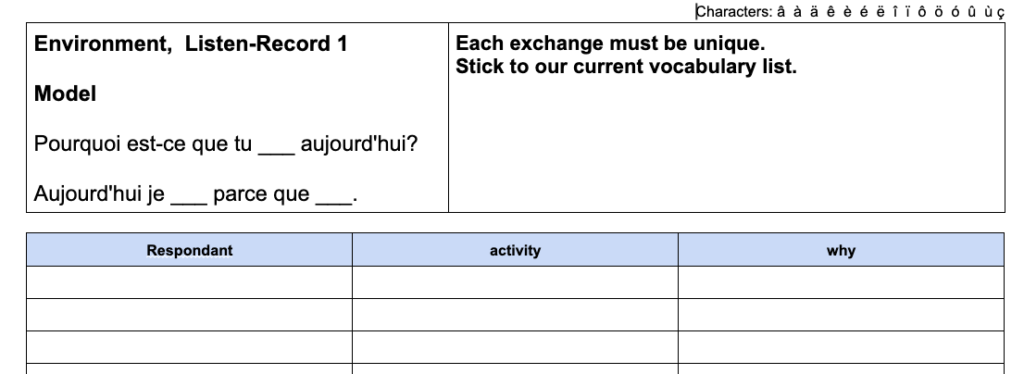
At the end of the lesson, there is a quiz on the table during which I ask, in the target language, who did or said such-and-such. students look up the name in the table and record the name on the answer sheet.
I echo out everything everyone says repeatedly, so this enhances the experience and recall.

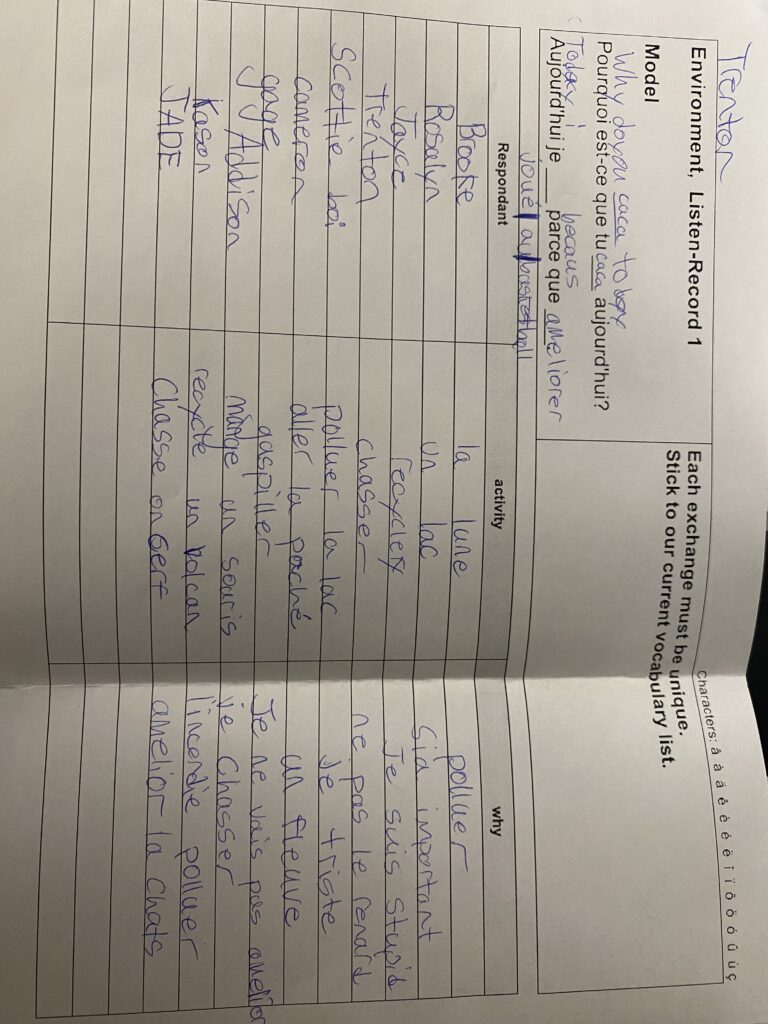
I really like this activity. Students have to be engaged all the time. They have to listen and practice speaking. They often improvise amusing permutations of the responses and this lends itself to long-term recall of the vocabulary. Best of all, this activity presents the same model phrases over and over. I echo out everything everyone says repeatedly, so this enhances the experience and recall.
“Guided Dialogue”, “Guided Conversation”, “Scaffold Dialogue”
These are all terms I have seen for a slightly different activity designed to build conversational competence with some improvisation. In the guided dialogue, the student participates in an extended conversation where every other exchange is in the target language. Back in the early 1990s, I found a British product for teaching French that was interesting. There were two books, an A and a B. Each chapter presented a different half of a conversation with necessary supportive materials like vocabulary and phrases. The activity was designed to have two students practice conversing.
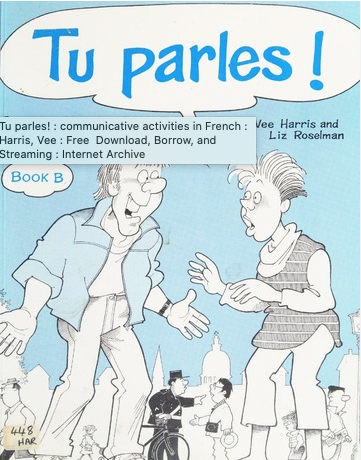
Shop for Scaffold Dialogue products at my store.
I tried on and off to use this during the time I taught French, from 1991 to 2004 (I taught social studies from ’04 to ’22). I could never get the students to commit to remaining in the target language throughout and that was the main reason I abandoned the activity. But I still wanted some kind of guided conversation that included scripted elements and improvised elements. I needed this to be topical so I could include it in a thematic lesson.
Reading and listening are important, but students who do too much of this and not enough speaking and writing without assistance end up notreally being able to use the language they toiled so hard to learn.
The Old French Regents Examination
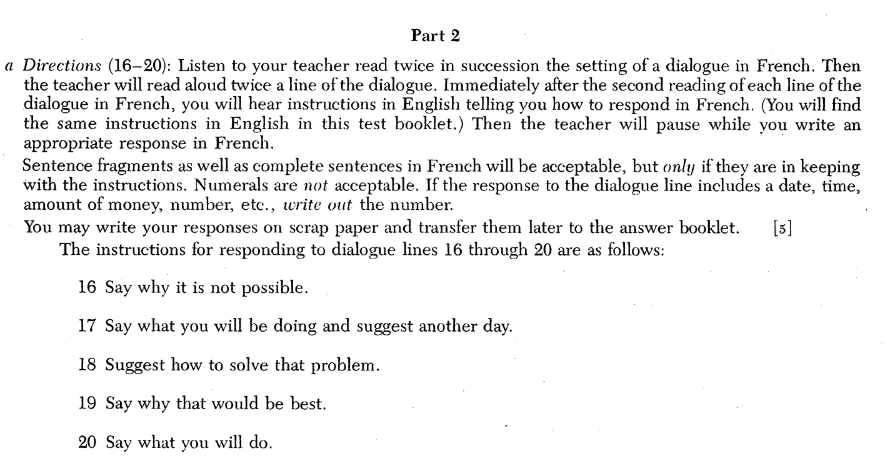
Those of you not in New York State may not know about our state testing system called Regents exams. Back in the 1980s, the old exams had a part that I liked but which was eliminated in the new exams in the 1990s. In this part, the teacher read a setting in French twice, then something in the target language to which student were to respond. There was a prompt in English telling students in a general way how to respond.
I like this exercise because it calls upon students to produce language. Many commercial world language programs heavily emphasize receptive language because it’s easier to grade. Reading and listening are important, but students who do too much of this and not enough speaking and writing without assistance end up not really being able to use the language they toiled so hard to learn.
The Scaffold Dialogue Package
Shop for Scaffold Dialogue products at my store.
Okay, so I’m not good at naming things… But the series of interconnected conversation lessons that I developed using all three of these experiences I will term the “Scaffold Dialogue Package”.
Step 1: Learn the Vocabulary – Students should use whatever methods they usually do to learn the words in the thematic list. I use the online flashcards and word bank quizzes here at InnovationAssessments.com.
Step 2: Complete the two listen-record tasks: For a class of twelve, this taskes about one 40-minute period. I have taught this using paper and digitally using Google docs. We all like paper better for this. I harvested grades for this by calculating percent correct on an open-notes quiz on the table.
Step 3: Complete the Scaffold Dialogue- The scaffold dialogue is based on the two listen-record tasks. It’s important to echo what each student says both for improving pronunciation and for letting people hear enough to record the elements in the table. To avoide confusing when I echo and when I am giving the teacher response, I say “s/he said…” before echoing what the student said. I have harvested scores for this in two ways. If I have time, I give an open-notes quiz. Otherwise, I collect the sheets and select one column to score. This takes a whole forty-minute class period for a class of about twelve. I leave a lot of scoring leeway for these if I grade a column. There can be no English and it has to have some significant elements of what the student said, but for younger learners that suffices. For French 3, I require a little more spelling accuracy.
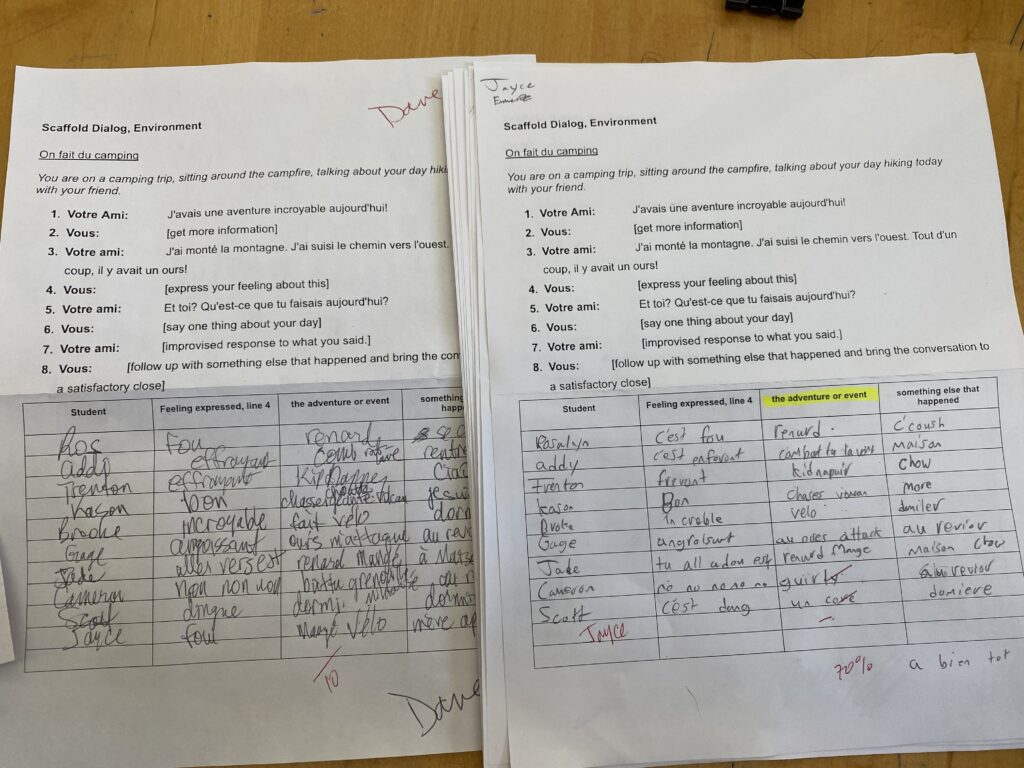
Step 4: The Test – Administer the test – it takes about twenty minutes or so. Repeat each item twice. When scoring, remember that only errors that affect auditory comprehension matter. Allow 2 free errors for French 1 and early French 2 and 1 free error for French 2 later in the course and French 3. I usually gathered a total score by calculating percent of checks out of fifteen.
For a class of twelve, the whole package takes about four class periods. Once students get in the habit of these, it goes rapidly. Each listen-record has a slightly different improvised structure, so there’s enough varation month to month for interest. Listen-record 1 usually is more basic and causes review of basic structures (like the Education one has students recall names of classes and school supplies). Listen-record 2 is more sophisticated, calling on students to offer opinions or to explain.